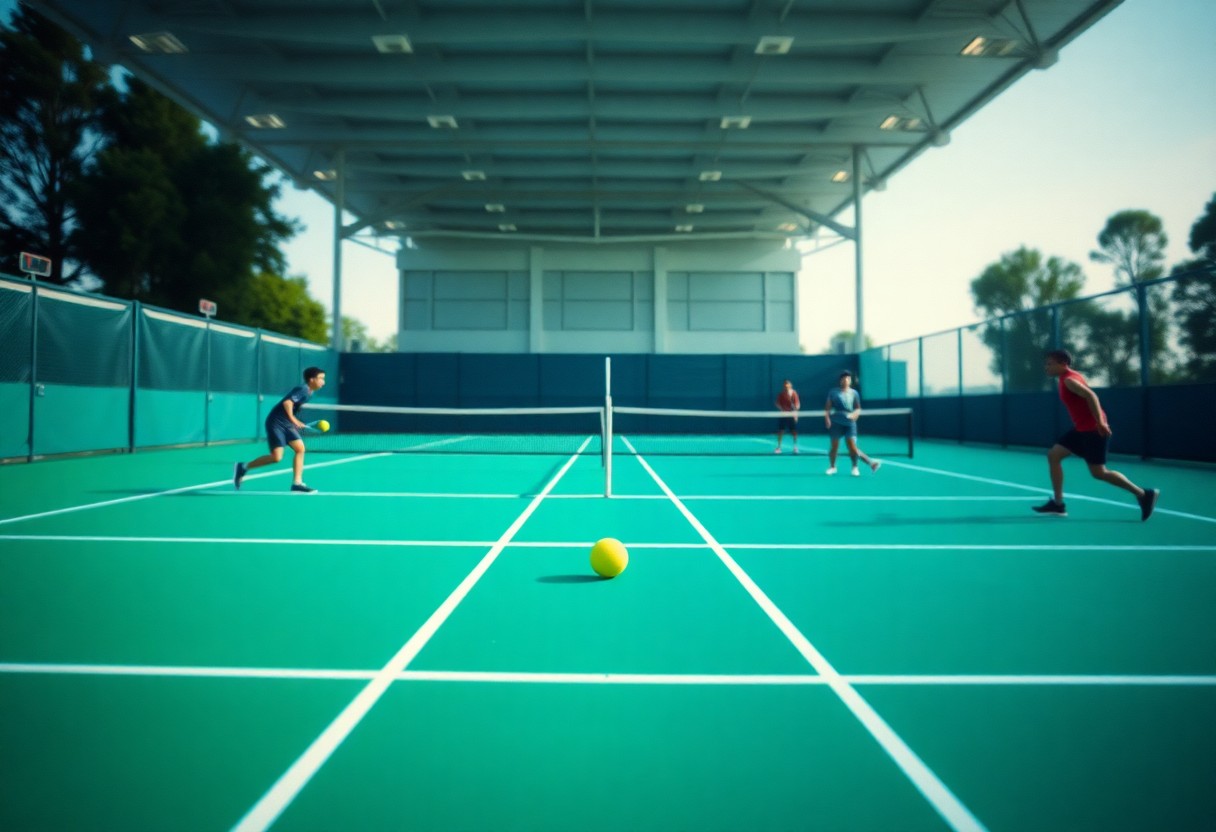You need a strategic approach to tennis that focuses on your strengths while exploiting your opponent’s weaknesses. A comprehensive game plan involves understanding your playing style, setting specific goals for each match, and adapting to varying conditions. By analyzing opponents and planning your shot selection, you can enhance your performance and increase your chances of success. This guide will equip you with practical tips to create an effective game plan that elevates your play, turning potential challenges into opportunities for victory.
Types of Tennis Game Plans
Understanding the different types of tennis game plans is necessary to tailor strategies that suit your strengths and opponent weaknesses. Here’s a breakdown of key plans:
| Offensive Play | Focuses on aggression and controlling the match tempo. |
| Defensive Play | Aims to counter opponents’ attacks while minimizing errors. |
| Counter-Attacking | Involves absorbing pressure before launching a surprise attack. |
| All-Court Strategy | Combines various tactics to keep opponents guessing. |
| Serving Strategies | Utilizes different serves to gain an advantage from the start. |
Recognizing how to adapt these game plans during a match is key to achieving success.
Offensive Strategies
Offensive strategies are designed to dominate the match by taking control early and applying pressure. Players should focus on hitting aggressive shots, prioritizing deep baseline shots and net approaches to force errors from their opponent. Utilizing variations in shot selection can create opportunities for winners and instill doubt in your opponent’s mind. This proactive approach allows players to dictate the pace and rhythm of the match.
Defensive Strategies
Defensive strategies are necessary for players looking to stay in the match against aggressive opponents. They focus on returning deep shots, positioning correctly, and minimizing unforced errors. Players must employ consistent groundstrokes combined with strategic shot placement, allowing them to absorb pressure while waiting for high-percentage shot opportunities. This tactical patience can ultimately lead to capitalizing on opponents’ mistakes.
Further expanding on defensive strategies, players should integrate techniques such as the use of slice shots to disrupt opponents’ timing and create challenging angles. Prioritizing court coverage and developing footwork enhances the ability to react to fast-paced rallies. Players should assess their opponents’ tendencies and target their weaknesses, ensuring their defensive game not only preserves energy but strategically positions them for a potential counterattack, turning defense into an offensive advantage when the moment arises.
Tips for Developing Your Game Plan
Creating a tailored game plan is vital for achieving success on the tennis court. Here are some key tips to consider:
- Always analyze your opponent’s playing style.
- Identify your own strengths and weaknesses.
- Develop a strategy based on court conditions.
- Adapt your approach during match play.
Any effective game plan relies on thorough preparation and adaptability.
Analyzing Your Opponent
Understanding your opponent’s strengths, weaknesses, and tendencies allows you to exploit their vulnerabilities. Pay attention to their preferred shots, serve patterns, and footwork. Use specific matches they’ve played as references to gauge how they respond under pressure. This insight can guide your tactical decisions during the match.
Assessing Your Strengths and Weaknesses
A clear self-assessment is integral to building a winning game plan. Identify your most effective shots and how well you handle different match situations. A player with a strong baseline game should focus on constructing points rather than rushing to the net. Conversely, if your serve is a weapon, use it to set up your attacks. Analyzing areas for improvement, like shot consistency or movement, allows for targeted practice. Focusing on enhancing specific skills can elevate your overall performance, enabling you to play at your highest level consistently.
Step-by-Step Guide to Creating a Match Plan
| Applying Your Knowledge | Use insights from previous matches to shape your strategies. |
| Analyzing Opponents | Study your opponent’s playing style and weaknesses. |
| Setting Goals | Define specific, measurable objectives for the match. |
| Developing Strategies | Formulate tactical approaches based on your goals. |
| Testing and Adjusting | Be prepared to refine your plan in real-time. |
Setting Goals for the Match
Establishing clear and actionable goals is vital for maintaining focus during the match. Whether aiming for a specific number of aces or minimizing unforced errors, these measurable objectives guide your performance. For instance, setting a goal of winning 70% of first serves solidifies your serve as a weapon while building confidence. Tailoring your ambitions to the match context enhances clarity, making right decisions more attainable.
Adjusting Your Strategy During the Match
The ability to pivot your game plan is vital for countering your opponent’s tactics. As the match progresses, stay attuned to your opponent’s strengths and weaknesses, making real-time adjustments—this may involve changing the placement of your shots or shifting to a more defensive style if needed. For example, if your opponent consistently attacks your forehand, consider employing more backhand-heavy strokes to disrupt their momentum.
Additionally, psychological factors, such as your opponent’s body language or confidence level, can inform your adjustments. If your opponent shows signs of frustration after a series of long rallies, exploit that weakness by engaging in more baseline exchanges. Tracking your performance against set goals and regularly assessing your match dynamics allows for informed adjustments that enhance competitiveness and, ultimately, contribute to match success.
Key Factors to Consider
When devising a match plan, several key factors must be evaluated to enhance your chances of success. Consider the following elements:
- Court Surface
- Player Fitness
- Mental State
- Opponent’s Style
This comprehensive assessment informs your strategy for optimal performance.
Court Surface and Conditions
The court surface significantly influences gameplay dynamics. Grass courts favor quick, low bounces, enhancing serve-and-volley strategies, while clay slows down the ball, requiring players to adapt with longer rallies. Adjust tactics based on whether the conditions are wet, dry, or windy, as they can further impact ball behavior and movement.
Player Fitness and Mental State
Evaluating player fitness and mental state is crucial before any match. A physically fit player can execute techniques more effectively while maintaining endurance. Mental resilience helps in dealing with pressure situations, allowing for better on-court decision-making and execution.
Research shows that players who engage in regular physical conditioning not only improve their endurance but also reduce the risk of injuries, thus increasing match longevity. Mental toughness, on the other hand, can be cultivated through techniques such as visualization and mindfulness, proving vital during tight match situations. This dual focus on fitness and mental preparedness can distinguish successful players from their peers.
Pros and Cons of Different Game Plans
| Pros | Cons |
|---|---|
| Enhances offensive strategy | Can lead to unforced errors |
| Builds confidence against opponents | May risk aggressive mistakes |
| Increases points won quickly | Can be mentally exhausting |
| Creates pressure on opponents | Less focus on defense |
| Exciting for spectators | Requires high skill level |
| Utilizes court space effectively | May become predictable |
| Encourages shot variety | Demanding on physical fitness |
| Quickly capitalizes on weaknesses | Increases pressure on player |
| Utilizes offensive formations | Less adaptability in matches |
| Creates momentum shifts | Potential for an early exit |
Advantages of Aggressive Play
Aggressive play often translates to domination on the court, allowing players to dictate the pace and style of the match. By applying pressure through powerful serves and groundstrokes, players can force opponents into defensive positions, leading to quick points. This approach can compel a rivalry, creating a thrilling atmosphere. Moreover, aggressive players may find it easier to exploit opponents’ weaknesses, ultimately increasing their chances of winning crucial points or matches.
Disadvantages of Conservative Play
While conservative play emphasizes stability and solid defense, it risks missing opportunities to seize control of the match. Players may hold back on challenging shots, allowing opponents to establish their rhythm and confidence. This sedentary approach can lead to prolonged rallies, testing endurance more than strategy. Notably, conservative players often struggle against aggressive opponents who thrive on taking risks, potentially limiting their competitiveness on the court.
Adopting a conservative game plan can also lead to the perception of being passive, which might impact a player’s mental game. For instance, a player waiting for the opponent to make mistakes may lose their momentum and become frustrated. This frustration can manifest in hesitance on key shots, leading to missed opportunities. In high-pressure situations, conservative players may find it challenging to shift strategies, ultimately hindering their ability to respond dynamically to opponent behavior and match developments.
Adapting Your Game Plan on the Fly
Adjusting your game plan during a match is imperative for outmaneuvering your opponent and capitalizing on their weaknesses. Successful players continuously assess their performance and the dynamics at play. Shifts in tactics can mean the difference between victory and defeat, especially when facing a skilled adversary who adapts quickly to your strategy. Emphasizing flexibility, awareness, and quick decision-making will ensure you remain competitive throughout the match.
Recognizing When to Pivot
Identifying the right moment to pivot your game plan often stems from observing patterns in your opponent’s strengths and weaknesses. For instance, if they consistently return your powerful serves with ease, it may indicate a need to alter your approach, perhaps by mixing up your serve speed or placement. Developing the ability to read their body language and shot selection can also signal when a change is necessary.
Implementing Changes Effectively
Executing a new strategy during a match requires both confidence and precision. After identifying the need to adapt, it’s imperative to implement changes in a structured manner. For instance, if you decide to adopt a more defensive strategy, focus on deep, consistent groundstrokes to push your opponent back, disrupting their rhythm. Conversely, if taking risks is warranted, aggressive net play can create pressure. Communicate adjustments with your on-court emotions; stay focused, maintain composure, and trust your training.
Effective implementation of changes also involves gradual integration rather than jarring shifts. Consider the timing of your new strategy; introducing adjustments during changeovers can give you the opportunity to mentally prepare. Visualize your new approach and the potential outcomes before executing it in rally situations. For example, if you’re shifting to a drop shot strategy, analyze the court position of your opponent and gauge the effectiveness of your earlier shot selections. Ultimately, practice under similar match conditions can greatly enhance your adaptability, ensuring the changes feel instinctive when required.
To wrap up
Now, a well-structured tennis game plan tailored to your strengths and your opponent’s weaknesses can significantly influence match outcomes. By analyzing previous performances, practicing specific strategies, and adapting to dynamic in-game situations, players can enhance their competitive edge. Consistent evaluation and adjustment of techniques ensure sustained improvement and readiness for any match scenario. Embrace this systematic approach to confidently navigate the complexities of competitive play.
FAQ
Q: What key elements should be included in a tennis game plan?
A: A successful tennis game plan should include the following elements: an analysis of your own strengths and weaknesses, a comprehensive evaluation of your opponent’s playing style, a strategic approach to shot selection, and a plan for adjusting tactics throughout the match based on real-time performance and conditions.
Q: How can I assess my opponent effectively during a match?
A: To assess your opponent during a match, observe their preferred shots, footwork, and weaknesses. Pay attention to their patterns, shot accuracy, and reaction to your strategies. Use this information to adapt your game plan in real-time, targeting their weaker shots and exploiting any inconsistencies.
Q: What strategies can enhance my mental preparation for executing a game plan?
A: Mental preparation can be enhanced through visualization techniques, setting specific match goals, and practicing mindfulness. Focus on maintaining a positive mindset, developing resilience to setbacks, and reinforcing confidence in your strategies to help execute your game plan effectively during the match.




